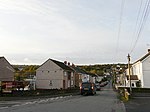Pontyberem railway station
Disused railway stations in CarmarthenshireFormer Great Western Railway stationsPages with no open date in Infobox stationRailway stations in Great Britain closed in 1953Railway stations in Great Britain opened in 1909 ... and 1 more
Use British English from November 2019

Pontyberem railway station was opened in 1909 to timetabled passenger services however services for miners began in 1898. It continued to serve the inhabitants of the Pontyberem area and hinterland between 1909 and 1953; it was one of several basic stations opened on the Burry Port and Gwendraeth Valley Railway in Carmarthenshire, Wales.
Excerpt from the Wikipedia article Pontyberem railway station (License: CC BY-SA 3.0, Authors, Images).Pontyberem railway station
Station Road,
Geographical coordinates (GPS) Address External links Nearby Places Show on map
Geographical coordinates (GPS)
| Latitude | Longitude |
|---|---|
| N 51.7809 ° | E -4.1635 ° |
Address
Pontyberem
Station Road
SA15 5LD , Pontyberem
Wales, United Kingdom
Open on Google Maps
